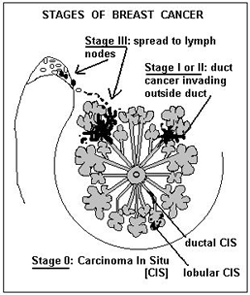
Cancers are classified by stage. Staging cancer is the process of finding out how far cancer has progressed when it is diagnosed. Information collected in staging is used to determine prognosis (outlook for cure versus the chance of cancer coming back or spreading to other organs) and to develop a treatment plan.
The stage of cancer tells you how far cancer has spread.
Stage 0
Means that the cancer has not spread at all. It composed of cancer cells but is still in situ, i.e. confined to the site [lobule or duct] where it started. 15 to 20 percent of breast cancers are now diagnosed at this very early stage of Carcinoma In-Situ or CIS.
Stage I
Means that the cancer has infiltrated outside the duct into the surrounding fat, but it is less than 2 centimetres across and has not spread to lymph nodes or anywhere else.
Stage II
Means that either (a) the cancer is more than 2cm across, or (b) it is still less than 2cm but has metastasised to the lymph nodes in the armpit [axilla].
Stage III
Means it has not only jumped to the lymph nodes but is outside the nodes as well, so they are stuck together.
Stage IV
Means the cancer has metastasised [spread] to distant areas, often to lungs, bone or ovaries. This usually happens when invading cancer cells insinuate themselves through the wall of a blood vessel, so they get swept off in the bloodstream to anywhere in the body.
The outcome of your cancer, how long you survive, depends partly on how far the tumour has spread when it is first discovered. And this will depend mostly on how vigilant you are at examining your breasts to check for any little lump, and slightly on the size of your breasts, as it will be easier for you to feel a tumour while it is still small in a small breast.
Women with low-stage tumours have a better chance of surviving breast cancer than women with high-stage tumours. Recent findings indicate that 5-year survival rates are 96% for limited, low-stage breast cancers (stage 0, stage I, and some stage II cancers), 75% for breast cancers that have invaded the surrounding tissue (stage II & III cancers), and only 20% for breast cancers that have metastasized (stage IV cancers). Unfortunately, survival rates are lower and breast cancer stages tend to be higher among women from low socioeconomic backgrounds.
